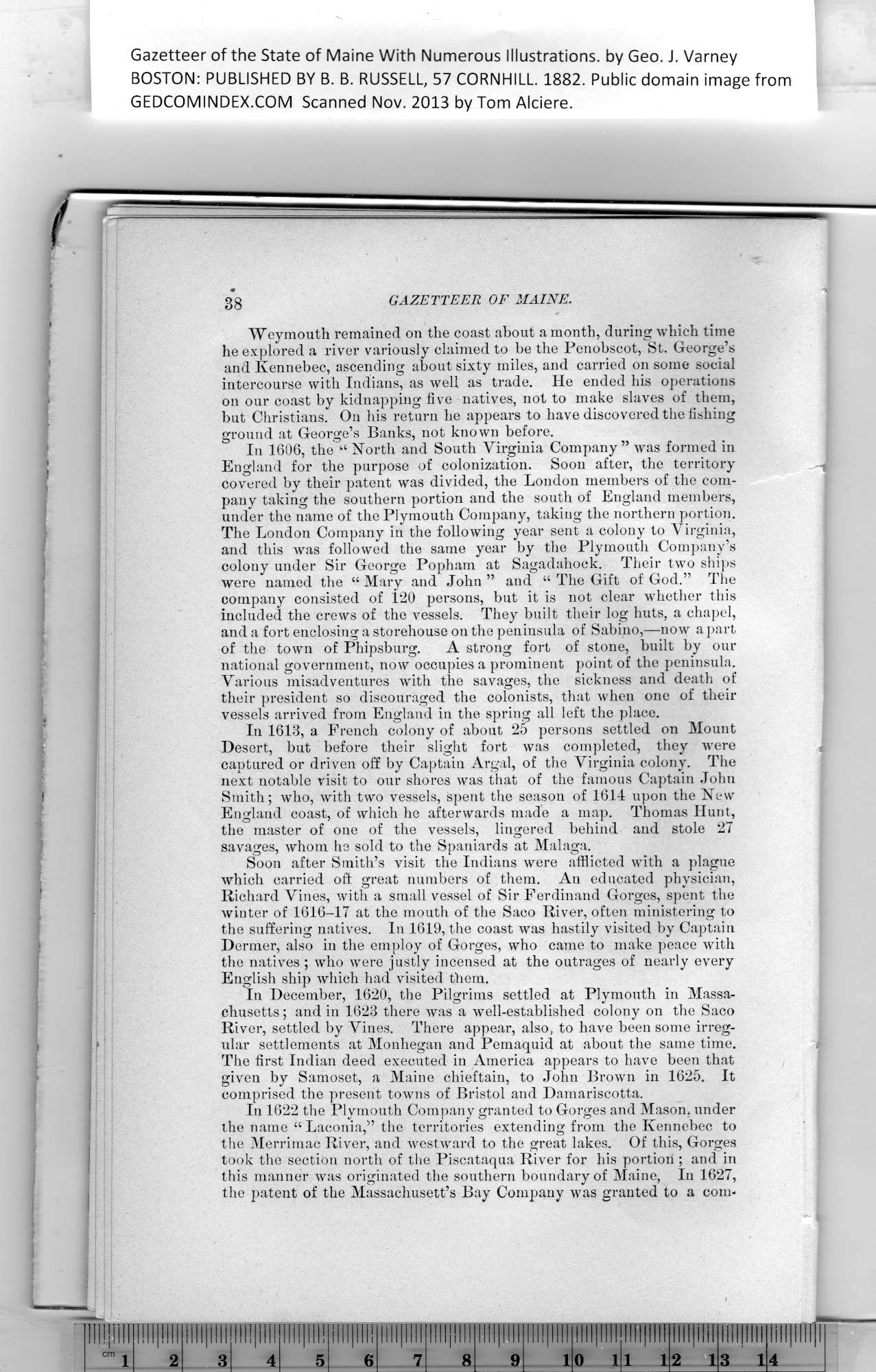|
Gazetteer of the State of Maine With Numerous Illustrations, by Geo. J. Varney
BOSTON: PUBLISHED BY B. B. RUSSELL, 57 CORNHILL. 1882. Public domain image from
3*8 GAZETTEER OF MAINE.
Weymouth remained on the coast about a month, during which time
he explored a river variously claimed to be the Penobscot, St. George’s
and Kennebec, ascending about sixty miles, and carried on some social
intercourse with Indians, as well as trade. He ended his operations
on our coast by kidnapping five natives, not to make slaves of them,
but Christians. On his return he appears to have discovered the fishing
ground at George’s Banks, not known before.
In 1606, the “ North and South Virginia Company” was formed in
England for the purpose of colonization. Soon after, the territory
covered by their patent was divided, the London members of the com-
pany taking the southern portion and the south of England members,
under the name of the Plymouth Company, taking the northern portion.
The London Company in the following year sent a colony to Virginia,
and this was followed the same year by the Plymouth Company’s
colony under Sir George Popham at Sagadahock. Their two ships
were named the “ Mary and John ” and “ The Gift of God.” The
company consisted of 120 persons, but it is not clear whether this
included the crews of the vessels. They built their log huts, a chapel,
and a fort enclosing a storehouse on the peninsula of Sabino,—now a part
of the town of Phipsburg. A strong fort of stone, built by our
national government, now occupies a prominent point of the peninsula.
Various misadventures with the savages, the sickness and death of
their president so discouraged the colonists, that when one of their
vessels arrived from England in the spring all left the place.
In 1613, a French colony of about 25 persons settled on Mount
Desert, but before their slight fort was completed, they were
captured or driven off by Captain Argal, of the Virginia colony. The
next notable visit to our shores was that of the famous Captain John
Smith; who, with two vessels, spent the season of 1614 upon the New
England coast, of which he afterwards made a map. Thomas Hunt,
the master of one of the vessels, lingered behind and stole 27
savages, whom he sold to the Spaniards at Malaga.
Soon after Smith’s visit the Indians were afflicted with a plague
which carried off great numbers of them. An educated physician,
Richard Vines, with a small vessel of Sir Ferdinand Gorges, spent the
winter of 1616-17 at the mouth of the Saco River, often ministering to
the suffering natives. In 1619, the coast was hastily visited by Captain
Dermer, also in the employ of Gorges, who came to make peace with
the natives ; who were justly incensed at the outrages of nearly every
English ship which had visited them.
In December, 1620, the Pilgrims settled at Plymouth in Massa-
chusetts ; and in 1623 there was a well-established colony on the Saco
River, settled by Vines. There appear, also, to have been some irreg-
ular settlements at Monhegan and Pemaquid at about the same time.
The first Indian deed executed in America appears to have been that
given by Samoset, a Maine chieftain, to John Brown in 1625. It
comprised the present towns of Bristol and Damariscotta.
In 1622 the Plymouth Company granted to Gorges and Mason, under
the name “ Laconia,” the territories extending from the Kennebec to
the Merrimac River, and westward to the great lakes. Of this, Gorges
took the section north of the Piscataqua River for his portion ; and in
this manner was originated the southern boundary of Maine, In 1627,
the patent of the Massachusett’s Bay Company was granted to a com.
PREVIOUS PAGE ... NEXT PAGE
This page was written in HTML using a program written in Python 3.2
|
